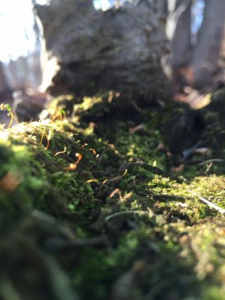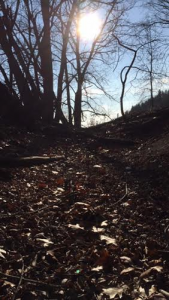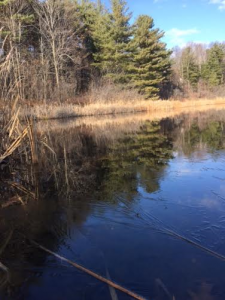The changes that have occurred since my last visit were astounding, as usual. All lingering leaves had fallen from the trees, and the vegetation looked even drier. All lingering hints of life vanished, leaving husks of what had been a vibrant  hub of plant and animal activity a few months earlier. The crickets I had heard on my last visit had not lingered- the nip in the air was enough of a warning for the approaching winter season. A thin veneer of sheet ice encased the pond, cracking around the edges of the flattened cattail patch. Sunlight showered the scene, creating a beautiful scene. The silence was only broken by a Pileated Woodpecker letting a call loose.
hub of plant and animal activity a few months earlier. The crickets I had heard on my last visit had not lingered- the nip in the air was enough of a warning for the approaching winter season. A thin veneer of sheet ice encased the pond, cracking around the edges of the flattened cattail patch. Sunlight showered the scene, creating a beautiful scene. The silence was only broken by a Pileated Woodpecker letting a call loose.
Archive for December, 2015
The first human interactions with my spot occurred roughly 11,300 years ago, when the Paleoindians moved into the Champlain Basin as the glaciers retreated (LCMM). These early humans were hunter- gatherers, and moved freely around the basin following herds of animals. As the climate warmed and many species of large animals became extinct, these small, migrating groups of Paleoindians began to condense and settle down. This shift occurred roughly 9,000 years ago, and the people of this time most likely relied more heavily on fishing than before (LCMM). Around 2,000 years ago, Native Americans of the Champlain Basin began farming, and slowly developed the “Three Sisters” method that was used when the Europeans arrived. The Three Sisters farming method was a very sustainable farming practice: The corn acted as a bean pole, allowing the beans to reach the sun. The beans naturally fix nitrogen, and would replace the nutrients that the corn and squash took out of the soil, and therefore maintained the soil quality. The squash acted as a climate and weed controller- its large leaves held moisture in the soil and shaded out potential competition.
gatherers, and moved freely around the basin following herds of animals. As the climate warmed and many species of large animals became extinct, these small, migrating groups of Paleoindians began to condense and settle down. This shift occurred roughly 9,000 years ago, and the people of this time most likely relied more heavily on fishing than before (LCMM). Around 2,000 years ago, Native Americans of the Champlain Basin began farming, and slowly developed the “Three Sisters” method that was used when the Europeans arrived. The Three Sisters farming method was a very sustainable farming practice: The corn acted as a bean pole, allowing the beans to reach the sun. The beans naturally fix nitrogen, and would replace the nutrients that the corn and squash took out of the soil, and therefore maintained the soil quality. The squash acted as a climate and weed controller- its large leaves held moisture in the soil and shaded out potential competition.
When the Europeans arrived in the Champlain basin in the 1600’s, they were met by the Abenaki, a Native American tribe that resided in the area. The Europeans began forcing the Abenaki out of the region and clear cut most of the region for farming. The European settlers then set up lumber processing plants, woodworking shops, boatbuilding yards, and machine shops. Tanneries, preservatives, and arsenic also contributed to the pollutant pool (History). The soil and lake became polluted from years of unregulated dumping. The North Beach area evolved from a lumber port, to a railyard, to a petroleum storage facility in the early 1900’s. By the 1970’s, the newfound environmental movement swept through the area, working to clean up the mess created and recreate a healthy natural space for organisms, both human and nonhuman alike to enjoy.
Throughout history, the area containing my phenology spot has endured many different human influences. In the beginning, there was very little impact caused by humans- hunter-gatherers did not even set up permanent settlements on the land and ranged around in small groups. Once they began settling and farming, they still had very minimal influence over the land. All farming, hunting and fishing techniques were refined until they could be carried out in sustainable ways. When the Europeans began settling in the area, these environmentally-friendly methods were discarded, and humans began having extremely harmful effects on the area. Presently, we are still negatively impacting the area, but we are beginning to turn ourselves around and look back to the sustainable ways of the Native Americans.
Social-Ecological systems show the interconnections between societies and ecosystems. They vary from place to place and person to person, but always reflect the interactions experienced within the place. I put together a social-ecological  system for my Burlington phenology spot, which reflects a mere portion of all of the synergy present at this location. In my diagram, there are several main groups that are directly attached to the central “Phenology Spot”, with equally important connections stemming from these areas. The main groups are People, Wildlife, Diversity of Ecosystems and Plants, Water Quality, Basis of Economy, and Indigenous and Local Values. The People and Values sections show how humans tie into and impact the spot, positively and negatively. On the positive side, nature enthusiasts fight for conservation and inform the general public of Nature’s beauty and suffering, which helps protect Nature. Specifically, the beach goers of the Burlington area experience the beauty of my spot, and wish to conserve it. On the negative side, nature enthusiasts and people in general can negatively impact my spot by disturbing and damaging parts of the system when exploring it. They also inadvertently cause disruption through pollution-runoff, litter, and common beach goer products such as sunscreen permeate the system, lowering water and habitat quality. People who wish to enjoy the area can cause habitat fragmentation and disruption through expanding human structures like fences, parking lots, and buildings. Development and infrastructure expansion also takes away from the natural system. Ecosystem degradation harms humans in the long run- they lose important ecosystem services such as wetland filtration, good water quality, and the benefits that stem from terrestrial forests and unfragmented wild.
system for my Burlington phenology spot, which reflects a mere portion of all of the synergy present at this location. In my diagram, there are several main groups that are directly attached to the central “Phenology Spot”, with equally important connections stemming from these areas. The main groups are People, Wildlife, Diversity of Ecosystems and Plants, Water Quality, Basis of Economy, and Indigenous and Local Values. The People and Values sections show how humans tie into and impact the spot, positively and negatively. On the positive side, nature enthusiasts fight for conservation and inform the general public of Nature’s beauty and suffering, which helps protect Nature. Specifically, the beach goers of the Burlington area experience the beauty of my spot, and wish to conserve it. On the negative side, nature enthusiasts and people in general can negatively impact my spot by disturbing and damaging parts of the system when exploring it. They also inadvertently cause disruption through pollution-runoff, litter, and common beach goer products such as sunscreen permeate the system, lowering water and habitat quality. People who wish to enjoy the area can cause habitat fragmentation and disruption through expanding human structures like fences, parking lots, and buildings. Development and infrastructure expansion also takes away from the natural system. Ecosystem degradation harms humans in the long run- they lose important ecosystem services such as wetland filtration, good water quality, and the benefits that stem from terrestrial forests and unfragmented wild.
 The second circle constitutes wildlife. High biodiversity can be connected to the health of the place, the higher the diversity, the healthier the system. Humans have a tendency to destroy or pollute integral parts of the ecosystem, resulting in loss of diversity. My phenology spot contains a high ecosystem diversification (yet another circle on the diagram), meaning that there are several micro-ecosystems that make up the overall ecosystem. In this case, there is a aquatic ecosystem, a wetland ecosystem, and a terrestrial ecosystem. This helps to create a wide range of organism habitat and ecosystem benefits, all of which can be lost with too much unnatural disruption.
The second circle constitutes wildlife. High biodiversity can be connected to the health of the place, the higher the diversity, the healthier the system. Humans have a tendency to destroy or pollute integral parts of the ecosystem, resulting in loss of diversity. My phenology spot contains a high ecosystem diversification (yet another circle on the diagram), meaning that there are several micro-ecosystems that make up the overall ecosystem. In this case, there is a aquatic ecosystem, a wetland ecosystem, and a terrestrial ecosystem. This helps to create a wide range of organism habitat and ecosystem benefits, all of which can be lost with too much unnatural disruption.
Water quality and Plant Diversity are the final natural aspects on my chart. These both directly impact the quality and quantity of life in the ecosystem. Water quality is important for healthy plants and animals, and important for humans if they wish to use said ecosystem for recreational or practical use. Plants directly relate to the animal life, so healthy and diversified vegetation is necessary for healthy and diversified animal life. Human development and hubs can pollute, fragment, or destroy natural spots that have good water and diversified vegetation, losing important ecosystem benefits and species.
Lastly, Local and Indigenous Views can highly impact a spot. If local values support development, the area has a higher chance of being converted into a developed spot. If local values lean towards nature, many places have a higher chance of remaining intact. Indigenous views always lean towards the side of nature, since their culture was about living at one with nature rather than subduing it. Luckily for my spot, the culture of Burlington supports the conservation of nature and people enjoy the natural beauty of the beach that my phenology spot is located on, which helps prevent destruction of my spot.
At this point, I consider myself to be an integral part of my spot. To be integrated into a place, I believe that a mutualistic relationship must be formed between the human and the spot. The spot must do something for the person; it must give them a sense of belonging, and must make them want to be there and want to protect the spot. In return, they must actually protect the spot- they must pick up trash and do their best to maintain a high quality of life for the inhabitants of their spot. There must be a deep connection of love and trust; the spot must be seen as not just a place but as an living entity, made up of many individual components that need each other in order to survive. I feel this connection with my spot- I feel at home there, relaxed and safe, and the spot openly welcomes me, allowing me to explore it and learn about it. I do my best to care for my spot, picking up trash and keeping it clean for all of its parts and pieces.
